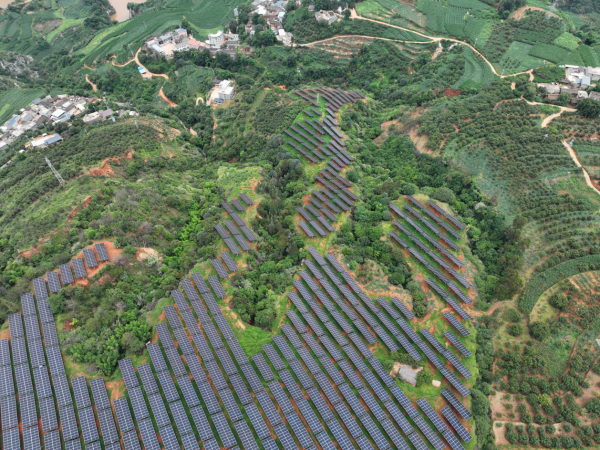In the mountainous terrain of Luquan Yi and Miao Ethnic Autonomous County in Kunming, Southwest China’s Yunnan Province, a slope measuring more than 250 hectares is undergoing a green transformation.
A deep blue photovoltaic matrix undulates like waves. Beneath the panels, vibrant vegetation thrives: ecological restoration plants take roots on the once exposed rocky surface, with medicinal herbs such as notoginseng and sealwort set to flourish in the cool shade in the near future.

A view of the Yunnan Luquan 200-megawatt agricultural photovoltaic project by the Dongfang Electric Corporation [Photo/sasac.gov.cn]
This harmonious scene of “power generation above, greenery below” is the vivid realization of the Yunnan Luquan 200-megawatt agricultural photovoltaic project by the Dongfang Electric Corporation (DEC), a state-owned enterprise based in Chengdu, capital city of Sichuan Province in Southwest China, embodying the company’s efforts to turn the concept of “lucid waters and lush mountains are invaluable assets”, a development philosophy China upholds in promoting ecological progress.
Facing the fragile ecological environment of the Yunnan-Guizhou Plateau, the DEC’s project team identified around 253 hectares of barren slopes for efficient land resource utilization. The team spent nearly 10 months in building up a 240-megawatt photovoltaic matrix on the mountain, setting a new record for high-altitude agricultural photovoltaic projects in China, and transforming barren mountains into a “blue energy base.”
The Yunnan Luquan 200-megawatt agricultural photovoltaic project has pioneered a “dual green development path,” reaping both ecological and economic benefits. On the one hand, it produces green energy with an annual electricity generation of 340 million kilowatt-hours, meeting the electricity needs of over 100,000 households, reducing carbon dioxide emissions by 269,600 tons annually, and contributing 15 percent of clean electricity to Luquan. On the other hand, the project has also revitalized the land by restoring vegetation under the solar panels, planting shade-tolerant crops, developing under-forest economies, and covering 253 hectares of rocky land with greenery, reducing soil erosion by 70 percent.
Additionally, by involving over 600 households in planting traditional medicinals under the panels, each household’s annual income will increase by over 5,000 yuan ($694), providing employment opportunities for over 2,700 locals.
As green electricity is transmitted to urban areas, the crops beneath the panels bloom with the hope of rural revitalization, increasing land's comprehensive benefits by over threefold.
The agricultural photovoltaic project commissioned by DEC is catalyzing profound transformations. In terms of technology, the high-altitude mountain photovoltaic construction standards it set provide replicable solutions for similar projects. It is expected to reduce cost by around 5 percent compared with that of similar projects and significantly accelerate the construction of photovoltaic projects on high-altitude mountain.
In the meantime, the project is driving the extension of the industrial chain of the photovoltaic sector in Yunnan, involving photovoltaic components, energy storage equipment, intelligent operation and maintenance, and more, laying the foundation for a green manufacturing cluster.
Moreover, DEC takes an innovative operation model by exploring the integration of “photovoltaic, ecological, and intelligent” sectors. Building upon the “power generation above + planting below” model, DEC has established a Smart Energy Center in Hangzhou and advanced the “smart operation and maintenance” system, aiming to achieve remote monitoring, troubleshooting, intelligent operation and maintenance on 11 photovoltaic projects nationwide, and enable real-time control over each solar panel.
As the project progresses, a new form of photosynthesis is taking place. It not only produces clean electricity and ecological wealth but also generates a harmonious symbiosis between humans and nature, offering a Chinese solution for sustainable development.
This “green energy beacon”, standing at 25 degrees north latitude, is illuminating the path towards sustainable development in more ecologically vulnerable regions.
(Executive editor: Yuan Ting)